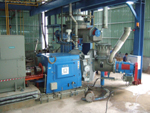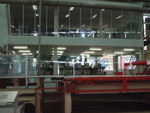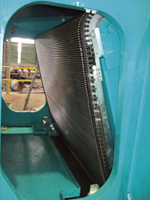An eye for detail
10 February 2009One year ago, WBPI visited Siam Fibreboard’s Hat Yai site and reported on the imminent start-up of its new 18MW electrical energy generation plant, which now has thetrading name GRE Energy Company Ltd (Thailand).This in fact started up in January 2008 but is already due for expansion in the near future as it is currently supplying sufficient power for the two (ex STA) Siempelkamp ContiRoll MDF lines already running at Siam Fibreboard but will not have enough capacity for the third line which has just started up.
At the time of that visit (November 2007), there was also a muddy field with some steel beams stored on it which was to become Siam Fibreboard’s third MDF line. The report on all this and more appeared in Issue 1, 2008, p36.
On returning to the site in late November 2008, I found that the MDF line was almost ready to begin production test runs, with the first board due within two weeks.
The first piles for the buildings on this riverside site were in fact sunk at the end of October 2007, with completion of this phase being achieved by the end of that year.
Within three months, the 75x400m production hall was up and weather-proof and by the time the line was running in December 2008, the whole project had taken around 14 months from start to finish on a greenfield site. We should not be surprised.
The man behind the Evergreen group’s meteoric rise in the Asian panel industry, JC Kuo, does not move slowly with his projects, however challenging they may be. But he does move carefully and with a great deal of planning.
In fact Mr Kuo’s company is now number one in MDF production volume in Asia, with 10 MDF lines, one particleboard line and a furniture manufacturing operation spread over sites in Thailand, Malaysia and Indonesia.
The panel mills are made up of a mixture of acquired existing businesses and greenfield start-ups but all have ultimately to fit in with the Evergreen philosophy, which can best be described as efficiency/cost/quality driven – in no particular order because all are vital ingredients to Mr Kuo.
In fact, when it comes to driving down costs, he has an eye for detail and an innovative hands-on approach which few panel companies this size could match. This runs from finding obsolete machinery parts on the internet for any one of the wide range of machinery to be found in the Evergreen Group, to manufacturing as many components of the plant as possible inhouse: Evergreen’s involvement in panel making goes far beyond the manufacturing process.
For instance, the company has logging operations in Thailand and Malaysia to both secure supplies and cut costs.
And in April 2008, a new company, Evergreen Adhesive and Chemicals Sdn Bhd, went into the production of melamine urea formaldehyde and urea formaldehyde resins to E1, E2, E0 and Super E0 for its own group factories and for sale to others.
This operation was established by working with Cal Polymers, who designed the plant, and then arranging sub-contractors to carry out the construction of the 96,000 tonne/year facility in Batu Pahat in Malaysia, across the road from Evergreen’s original two MDF lines.
Mr Kuo also started up another new company in 2008, based in his home country of Singapore, though details of that venture are not yet ready to be released.
Coming back to the main subject of this article – MDF line number three at Hat Yai – the heart of the line was supplied by German machinery company Dieffenbacher, with contracts being signed in April 2007 covering dryer, forming, continuous press and the controls for the finishing line, which was fabricated in Malaysia in another of Mr Kuo’s cost-cutting initiatives.
Delivery of the 8ftx28m CPS press and other machinery took longer than Mr Kuo would have liked, due to the volume of business being placed with all the major machinery suppliers at that time causing extended lead times. Designed line speed is 2m/second on thin board production.
Andritz of Austria supplied the refiner, a 59in unit guaranteed for 30 tons/hour, while the energy plant came from GTS’ factory in China.
The two Steinemann sanders were both good condition secondhand units: one eight-head from Italy where it had only been in use for one year and the other a well-maintained machine from Nelson Pine of New Zealand with six sanding and two super-finishing heads.
The Anthon saw system was also secondhand, this time from Pfleiderer in Germany.
Because the two sanding lines are exiting to one cut-to-size operation, Evergreen designed its own stacking, handling and conveying system. “We made a lot of savings there,said Mr Kuo proudly. “This whole line is unique – the design had a lot of our input.”
In another example of this approach, the entire production line is set at ground level as is the ‘fish tank’ all-glass control room, from which the whole line and refining area is clearly visible. The control system is also set up for direct online service from Dieffenbacher in Eppingen, Germany; Evergreen’s engineers have wireless headsets with a 50m range connected to this system.
“This [control room] was our design – you can access the whole line easily without having to go up and down stairs,said Mr Kuo. The foundations for the press had to be deeper but the rest of the line did not require so much supporting structure.”
The finishing line is in fact raised above the rest to help in slowing the progress of thin board.
The entire production floor was raised on made-up ground by 0.5m above original ground level due to some risk of flooding in this area.
The drum debarker was Evergreen’s own design and manufacture, while the two chippers were made in Malaysia, the same as for the first two Hat Yai lines. The third, re-chipper, for over-size and very small roundwood, was made in China. Chips are screened in a Pal of Italy system.
A lot of thought went into the design of the whole woodyard area as well.
“This is also unique to us,said Mr Kuo. “All wood comes back to the same place. Waste wood such as bark, mat dump, forming station trim, everything for recycling into production or for burning comes back to the wood preparation area and everything is stored undercover in the dry. Wood destined for the energy plant goes into one large silo with a moving floor.”
The wet chip silo has two compartments in case the company decides to have a mixed wood supply at a later date (currently it is 100% rubberwood) or decides to separate wood raw material for any other reason.
The sanding line is also located close to the energy plant in order to reduce transport of dust and there are separate sawdust and sanding dust silos.
“In a way, we have designed the factory around the energy plant to have a more efficient, cleaner system with less transport costs,said Mr Kuo. “We also designed the switch room and transformers to have a central location, with the forming transformers adjacent to the forming station and the energy plant transformers close to the energy plant and so on. This whole plant is designed for maximum efficiency.”
Currently, the factory uses conventional blowline blending but is set up to facilitate the possible use of mechanical blending in the future.
Forming employs only one head at present, since the factory employs double-sifting of the fibre, but there is space for an additional forming head if required.
Protecting the whole plant is a Firefly spark detection system, while an Instalmec system removes fumes from the press area and cleans them. “This is important fire prevention, especially when running thin board as it avoids fibre build-up in the ducts,commented Mr Kuo.
Quality control on the production line was supplied by Imal.
Another of Mr Kuo’s thoughtful design details has the thermal oil pipes on the press connected in such a way that the pipes for the lower platen go downwards and those for the upper platen go upwards so that they do not obstruct the side of the press for cleaning. The thermal oil pipes are also suspended with counterbalances to allow for expansion and contraction – a modification necessitated by their unique routing.
One can see that every detail of this factory has been considered and analysed to both reduce costs and increase efficiency in every area. In the current difficult market, this kind of almost obsessive attention to detail may just make the difference between profit and loss.
A range of investments
You may think that building a complete new MDF line in Thailand would be enough to be getting on with in one year, but Evergreen has a continuous programme of investment in all areas of
its business.
In Johor Bahru in Malaysia, the company has an MDF factory which it bought from Merbok (formerly the Takeuchi mill) in December 2006.
This has one Mende-type thin board line and one Küsters continuous line, giving a joint capacity of around 480,000m3 a year.
The factory experienced a fire in September 2007 and restarted in the first quarter of 2008, but Mr Kuo plans to upgrade the continuous press in early 2009 with a new gearbox and other modifications which he anticipates will lead to a 15-20% increase in capacity.
Meanwhile, the main drum of the Mende press has been replaced with a new one from Kalzenbach of Germany.
“The normal lifespan of a drum is about 10 years and this one was 16 years old,said Mr Kuo.
The drum on the similar press at Evergreen’s original Batu Pahat factory was also changed three or four years ago.
At the Allgreen particleboard factory in Segamat, southern peninsular Malaysia, the two-opening Dieffenbacher press was in the process of being overhauled and upgraded in November 2008.
Meanwhile, the ready-to-assemble furniture factory in Parit Raja, the founding company of the group, entered the office furniture business last year, in addition to its existing range of domestic furniture.
Turning to Indonesia, the joint venture MDF factory near Palembang in northern Sumatra, PT Hijau Lestari Jaya, which joined the group in August 2007 (WBPI issue 1, 2008, p27), started production in April last year and is now heading for an output of 11,000m3/month.
The latest addition to the Evergreen empire is the former Hume Fibreboard factory in Nilai in peninsular Malaysia. It is now known as Evergreen Fibreboard (Nilai) Sdn Bhd, but that is, literally, another story (see p43 in this issue).
The future
So what of the future in these difficult economic times? I asked Mr Kuo about his plans.
“Cost-cutting is ongoing,he said. “We have a lot of skills in the group and a lot of plants, all of whom are continually learning from one another. We have three of the longest-established MDF lines in South East Asia and all that experience comes together to help us survive.
“We are also able to offer everything from resin to MDF to particleboard and DIY furniture kits.”
With such a spread of experience and products, together with Mr Kuo’s keen eye for cost-saving and increasing efficiency in all his plants, Evergreen could well have a better chance than most of surviving the economic downturn.


